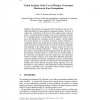Free Online Productivity Tools
i2Speak
i2Symbol
i2OCR
iTex2Img
iWeb2Print
iWeb2Shot
i2Type
iPdf2Split
iPdf2Merge
i2Bopomofo
i2Arabic
i2Style
i2Image
i2PDF
iLatex2Rtf
Sci2ools
AVBPA
2003
Springer
2003
Springer
Visual Analysis of the Use of Mixture Covariance Matrices in Face Recognition
The quadratic discriminant (QD) classifier has proved to be simple and effective in many pattern recognition problems. However, it requires the computation of the inverse of the sample group covariance matrix. In many biometric problems, such as face recognition, the number of training patterns is considerably smaller than the number of features, and therefore the covariance matrix is singular. Several studies have shown that the use of mixture covariance matrices defined as a combination between the sample group covariance matrices and, for instance, the pooled covariance matrix, not only overcomes the singularity and instability of the sample group covariance matrices but also improves the QD classifier performance. However, little attention has been paid to understanding what has happened with the final shape of these mixture covariance matrices. In this work, we visually analyse in the commonly used eigenfaces space the eigenvectors and eigenvalues of these covariance matrices, giv...
| Added | 06 Jul 2010 |
| Updated | 06 Jul 2010 |
| Type | Conference |
| Year | 2003 |
| Where | AVBPA |
| Authors | Carlos E. Thomaz, Duncan Fyfe Gillies |
Comments (0)

